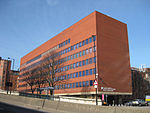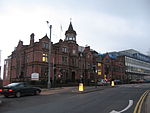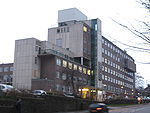Firth Court

Firth Court is a Grade II listed Edwardian red-brick building that forms part of the Western Bank Campus of the University of Sheffield in the United Kingdom. Located on the northern side of Western Bank, it is the main administrative centre for the university and also houses the Departments of Molecular Biology and Biotechnology and Biomedical Science. The main entrance to Firth Court is on floor C, from this point up there are four complete floors (up to F floor which houses the first of the Molecular Biology and Biotechnology lecture theatres (F2) and research labs) and then G floor which is divided into several sections (housing the second lecture theatre (G2) and seminar rooms). This gives the five floors sometimes quoted, however the department's nuclear magnetic resonance (NMR) facility extends downwards from floor C and is housed on B (which is ground level at the back of the building), A and a further floor below this which has no official designation. In places the building extends above G floor, these towers do not have official floor letters but extend to what would be I floor. Counted from the bottom of the NMR pit to the highest research laboratory (that of Milton Wainwright) Firth court is 10 floors. The Main Block of Firth Court is linked, via the Addison Building, to the Alfred Denny Building. The Edwardian Block also links the North Block to the Perak Laboratories.
Excerpt from the Wikipedia article Firth Court (License: CC BY-SA 3.0, Authors, Images).Firth Court
Western Bank, Sheffield Netherthorpe
Geographical coordinates (GPS) Address External links Nearby Places Show on map
Geographical coordinates (GPS)
| Latitude | Longitude |
|---|---|
| N 53.381314 ° | E -1.488556 ° |
Address
Firth Court
Western Bank
S10 2TQ Sheffield, Netherthorpe
England, United Kingdom
Open on Google Maps







